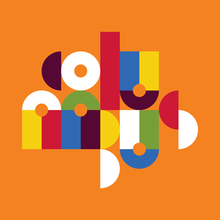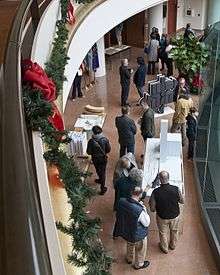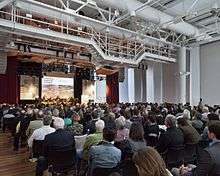Exhibit Columbus
Exhibit Columbus is the flagship program of Landmark Columbus Foundation, whose mission is to care for the design heritage of Columbus and inspire communities to invest in architecture, art, and design to improve people's lives and make cities better places to live. Exhibit Columbus is an "annual exploration of architecture, art, design, and community," that alternates between symposium and exhibition programming each year, and features the J. Irwin and Xenia S. Miller Prize.[1][2]
| Exhibit Columbus | |
|---|---|
 Exhibit Columbus | |
| Genre | Festival, Biennale |
| Begins | 2016 |
| Frequency | Annually |
| Location(s) | Columbus, Indiana |
| Years active | 3 |
| Inaugurated | 2016 |
| Founder | Landmark Columbus |
| Website | http://www.exhibitcolumbus.org |
The award-winning and critically acclaimed project has been credited with renewing the design legacy of Columbus, Indiana.[3][4] After hosting its inaugural symposium, "Foundations and Futures," in fall 2016 and inaugural exhibition in Fall 2017, the 2018 symposium, "Design, Community, and Progressive Preservation" took place in September 2018. The second exhibition, "Good Design and the Community: Columbus, Indiana," ran from August 24 to December 1, 2019. Exhibit Columbus has four key components: The Miller Prize, High School Design Team, University Design Research Fellowships, Washington Street Civic Projects, and Environmental design and Wayfinding.[5]
2019 Exhibition
The 2019 exhibition participants were announced in the Summer 2018, and participated as speakers in the 2018 National Symposium: Design, Community, and Progressive Preservation. The exhibition opened on August 24 and ran through December 1, 2019.
The exhibition featured 18 site-responsive installations by architects, designers, academics, artists, and graphic designers. These designers created outdoor installations and experiences that used Columbus’ built heritage as inspiration and context, while highlighting the role that visionary community plays in growing a vibrant, sustainable, and equitable city.
For inspiration, Exhibit Columbus looked to the 1986 exhibition, Good Design and the Community: Columbus, Indiana, created when Columbus business leader and philanthropist J. Irwin Miller became the first person inducted into the National Building Museum Hall of Fame in Washington. Mr. Miller chose to emphasize the community's process and involvement in building, rather than the architecture itself, as a source of his hometown pride.
Elaborating on the connection between the tangible and intangible culture that Mr. Miller described, the 2019 exhibition explored the idea of “good design in the community,” and what it means today.
2019 Miller Prize Recipients
The 2019 exhibition will feature five J. Irwin and Xenia S. Miller Prize recipients:[10]
- Agency Landscape + Planning (Cambridge, MA)
- Site: AT&T Facility, 1978, Paul Kennon of Caudill Rowlett Scott
- Bryony Roberts Studio (New York, NY)
- Site: Columbus City Hall, 1981, Edward Charles Bassett, Skidmore, Owings, and Merrill
- Frida Escobedo Studio (Mexico City, Mexico)
- Site: Cleo Rogers Memorial Library Plaza, 1971, I.M. Pei and Partners
- MASS Design Group (Boston, MA; Kigali, Rwanda)
- Site: Central Middle School, 2007, Ralph Johnson of Perkins + Will
- SO-IL (New York, NY)
- Site: Bartholomew County Courthouse Lawn, 1871-74, Isaac Hodgson
Washington Street Civic Projects
- Borderless Studio (Chicago)
- Extrapolation Factory (New York)
- LA Más (Los Angeles)
- People for Urban Progress (Indianapolis)
- PienZa Sostenible (Mexico City)
University Design Research Fellows
These fellowships were created to showcase current research by leading professors of architecture and design and highlight innovative research that explores ways that architecture and design can improve people's lives and make cities stronger
- Viola Ago and Hans Tursack (Ohio State University and Massachusetts Institute of Technology)
- Sean Ahlquist (University of Michigan)
- Christopher Battaglia (Ball State University)
- Sean Lally and Matthew Wizinsky (University of Illinois at Chicago and University of Cincinnati)
- Daniel Luis Martinez and Etien Santiago (Indiana University)
- Marshall Prado (University of Tennessee)
High School Design Team
Columbus’ architectural legacy and its impact on the community started with investments made in the schools. The commissioning of innovative, well-designed educational facilities helped create what can be seen today: a quality, forward-thinking educational system. Inspired by J. Irwin Miller's vision, Exhibit Columbus seeks to connect the next generation of the Columbus community to its design heritage through the High School Design Team.
Environmental design and wayfinding
Thirst is designing a system that provides a cohesive experience that connects each installation.
The Environmental Design and Wayfinding of the 2019 Exhibition unified the many facets of the exhibition through a system of color-coded installation kiosks and an exhibition guide design by Thirst, with complimentary guides in the form of a Family Activity Guide designed by Rosten Woo, and the Hear/Here app created by Halsey Burgund. Exhibit Columbus considers Environmental Design and Wayfinding as the 18th installation as it forms a continuous language that serves to inspire, educate, and connect to Exhibit Columbus’ purpose and the exhibition theme.
Publications, mobile app, and videos
Exhibit Columbus sought to provide an enjoyable and meaningful experience for all ages.[11] The Family Activity Guide, designed by Rosten Woo, invited children and families to learn about and interact with the exhibition, as well as interpret Columbus’ design heritage.
Hear/Here is an interactive location-based audio app that offers an aural exploration of the exhibition and invites visitors to upload their own voices. Historic audio clips, insights from community members, and interviews with exhibition participants come together in the Hear/Here app––creating a new way to interact with the exhibition and experience the city's design legacy.
2018 symposium
The 2018 symposium took place September 26 to September 29,[12] and was created in partnership with Docomomo US, American Institute of Architects Indiana and Kentucky, and the Indianapolis Museum of Art at Newfields.[13] The theme for the symposium is Design, Community, and Progressive Preservation, a title which recognizes the need to look for forward looking preservation plans in the future of cities.[14] The Architect's Newspaper proclaimed that the symposium was "unburdened by the lack of old-school historic preservation and architectural history thought chains, and discussion instead focused on innovation, creativity, and participation over historical facts delivered by academics."[15] Over four days about 1200 attendees [16] experienced sessions in many of the historic buildings throughout Columbus. The symposium culminated with introductory remarks from the 2019 Miller Prize Winners.
2017 exhibition
The 2017 exhibition opened on 26 August and features 18 site-responsive installations in downtown Columbus. Funding from the project has come from a number of individuals, corporations, and foundations in the region, including the Ball State University, Cummins, Indiana University, Efroymson Family Fund, and the Graham Foundation for Advanced Studies in the Fine Arts.[17] The eighteen installations on view during the inaugural exhibition were:[18]
Miller Prize Installations
Five projects of architecture or art that are in conversation with one of the Miller Prize Sites;[19]
- Another Circle by Aranda\Lasch at Mill Race Park[20]
- Anything can happen in the woods by Plan B at the Cummins Office Building[21]
- The Exchange by Oyler Wu at the Irwin Conference Center[22]
- Wiikiaami by studio:indigenous at First Christian Church[23]
- Conversation Plinth by IKD at Cleo Rogers Memorial Library[24]
2016 Miller Prize Finalists
- Benjamin Aranda and Chris Lasch of Aranda\Lasch (Tucson, AZ and New York, NY)
- Benjamin Ball and Gaston Nogues of Ball-Nogues Studio (Los Angeles, CA)
- Herwig Baumgartner and Scott Uriu of Baumgartner + Uriu (Los Angeles, CA)
- Rachel Hayes of Rachel B. Hayes Studio (Tulsa, OK)
- Eric Höweler and Meejin Yoon of Höweler+Yoon (Boston, MA)
- Yugon Kim and Tomomi Itakura of IKD (Boston, MA)
- Sharon Johnston, Mark Lee, and Jonathan Olivares of Johnston Marklee and Jonathan Olivares (Los Angeles, CA)
- Dwayne Oyler and Jenny Wu of Oyler Wu Collaborative (Los Angeles, CA)
- Joyce Hsiang and Bimal Mendis of Plan B Architecture & Urbanism (New Haven, CT)
- Chris Cornelius of studio:indigenous (Milwaukee, WI)
2016-17 Miller Prize sites
- First Christian Church (1942) by Saarinen and Saarinen
- Irwin Conference Center (1954) by Eero Saarinen and Associates
- Cleo Rogers Memorial Library (1969) by I.M. Pei and Partners
- Cummins Corporate Office Building (1984) by Kevin Roche John Dinkeloo Associates
- Mill Race Park (1992) by Michael Van Valkenburgh Associates with architecture by Stanley Saitowitz.[25]
2016 Miller Prize Juried Presentations

On 10 December the 10 Miller Prize finalists presented their concepts to a jury that will decide the winners.[26] The presentations took place at Columbus City Hall.[27] The jury for the competition consisted of:
- Sean Anderson, Museum of Modern Art
- Lise Anne Couture, Asymptote Architecture
- Jennifer Dunlop Fletcher, San Francisco Museum of Modern Art
- Dung Ngo, August Editions
- Jason Hatton, Bartholomew County Public Library
- Mark Jones, Columbus Parks and Recreation
- Brad Manns, Cummins Inc.
- Larry Ruble, First Christian Church
Washington Street Installations
Five installations by designers selected by leading design galleries;
University Installations
Five installations created by architecture schools:
- Ball State University College of Architecture and Planning
- The Ohio State University Austin E. Knowlton School of Architecture
- University of Cincinnati School of Architecture and Interior Design
- University of Kentucky School of Architecture
- University of Michigan Taubman College of Architecture and Urban Planning
- Plus an installation created by students in the Indiana University School of Art and Design;[33][34]
High School Installation
- Between the Threads by high school students from Columbus schools.[35]
Image and Environmental Design
- Street banners, way finding, and publications by Thirst, a Chicago-based graphic design company.
Iterations of installations
Many of the temporary installations from the exhibition have gone on to be exhibited in other exhibitions or at new sites.
- Alchemy was exhibited as part of the 2018 Venice Biennale of Architecture.[36]
- Playhouse was exhibited as part of a retrospective for Snarkitecture at the National Building Museum[37] in the summer of 2018.[38]
- Theoretical Foyer by Cody Hoyt was given to the City of Columbus by Patrick Parish Gallery.[39]
2016 symposium

The 2016 symposium took place September 29 to October 1 and was entitled "Foundations and Futures." It featured a sold out keynote session[40] with Deborah Berke, Will Miller, Robert A. M. Stern, and Michael Van Valkenburgh and sessions with experts on the history of Modern architecture, Columbus, Indiana, fabrication, and the community.[41][42]
The symposium was billed as the first step to launch the first exhibition which is slated to take place in August 2017.[43] All ten of the 2016 Miller Prize Finalists were featured in panel discussions. The 2016 symposium was recognized by NUVO as a "2016 Best Of Editors Pick."[44]
Project development
Early planning work for Exhibit Columbus began in late 2014, and the project was officially launched on 5 May 2016 in Columbus as a program of Heritage Fund—The Community Foundation of Bartholomew County. It receives funding from a number of local and regional individuals, foundations, and corporations.
100 Variations
An exhibition was developed in the fall of 2014 as a pilot project that featured designer Jonathan Nesci[45] who created 100 unique tables for an installation in front of First Christian Church. This exhibition, "100 Variations," was produced by Indianapolis-based curator, Christopher West with support from the Haddad Foundation, the Columbus Area Visitors Center, and the Columbus Museum of Art and Design.[46] Each of the tables was made by Noblitt Fabricating[47] in Columbus, Indiana under the leadership of Curt Aton.[48]
Graphic identity
The Chicago-based graphic design firm, Thirst, was hired in 2016 to create the Exhibit Columbus identity with the goal of creating a system that was aligned with Paul Rand's designs in Columbus, along with Alexander Girard's work at the Miller House and Garden.[49] This identity was immediately recognized with an award from the Society of Typographic Artists, and has gone on to considerable critical acclaim.[50] The identity was primarily created by Rick Valicenti, a 2006 AIGA medalist and a 2009 National Design Award winner.
See also
- ArtPrize
- Chicago Architecture Biennial
- Design Indaba
- List of architecture prizes
- Prospect New Orleans
- Venice Biennale of Architecture
References
- Blair, Brian. "Architecture initiative honors aficionados, both old and emerging". The Republic. Retrieved 14 May 2016.
- Blair, Brian (1 July 2016). "Exhibit Columbus has eye on the prize". The Republic. Retrieved 2 July 2016.
- Loos, Ted (18 August 2017). "Columbus, Ind., Renews Its Big Design Legacy". The New York Times. Retrieved 16 December 2017.
- "Columbus Chamber recognizes volunteers, project and teacher with awards". wkkg.com. 29 March 2018. Retrieved 8 October 2018.
- "Exhibit Columbus Announces National Symposium Details". News - Indiana Public Media. Retrieved 2 March 2018.
- "Exhibit Columbus to feature new J. Irwin and Xenia Miller Prize | 101.5 WKKG". 101.5 WKKG. 5 May 2016. Retrieved 14 May 2016.
- Blasius, Elizabeth. "Miller Prize winners announced ahead of the Exhibit Columbus 2018 National Symposium - Archpaper.com". archpaper.com (19 July 2019). Retrieved 13 September 2018.
- Hagberg Fisher, Eva (25 January 2019). "Indiana’s Exhibit Columbus festival promises to celebrate women in architecture". Wallpaper*. Retrieved 26 January 2019.
- Blair, Brian (20 January 2019). "The good earth: New Exhibit Columbus Miller Prize installations lean heavily to landscape architecture". The Republic. Retrieved 26 January 2019.
- Sitz, Mirriam (19 July 2018). "Exhibit Columbus Announces 2018–2019 Miller Prize Recipients". Retrieved 1 September 2018.
- Capps, Kriston. "A Small City Famous for Architecture Rolls Out the Welcome Mat". City Lab. Retrieved 5 January 2020.
- McGowan, Dan (26 September 2018). "Exhibit Columbus National Symposium Ignites". Retrieved 10 October 2018.
- "Exhibit Columbus announces 2018 National Symposium - Local News Digital". localnewsdigital.com. Retrieved 8 April 2018.
- Prudon, Theodore (13 September 2018). "The Docomomo Symposium brings progressive preservation to Indiana - Archpaper.com". archpaper.com. Retrieved 13 September 2018.
- Blasius, Elizabeth (9 October 2018). "Exhibit Columbus National Symposium embraces progressive preservation - Archpaper.com". archpaper.com. Retrieved 10 October 2018.
- Blair, Brian (1 October 2018). "Symposium draws 1200 details emerge for 2019 exhibition". Retrieved 10 October 2018.
- "Graham Foundation > Grantees > Heritage Fund-The Community Foundation of Bartholomew County-Landmark Columbus". www.grahamfoundation.org. Retrieved 16 December 2017.
- "A Cheese Lady at the Fair, Designers in Columbus, and Attucks on Film". WFYI Public Media. Retrieved 13 August 2016.
- Shaw, Matt (5 May 2016). "Columbus, Indiana announces biennial design exhibition to begin in fall 2017". Archpaper.com | Serving up news and inside reports to a niche community interested in the built urban environment. Retrieved 14 May 2016.
- Blair, Brian. "Stones project in Mill Race offers ties to Hoosier past". The Republic.
- Blair, Brian. "Inspired Creation: Architectural installation to emulate 'enchanted' forest". The Republic. Retrieved 29 July 2017.
- Blair, Brian. "Complementary creation: Los Angeles designers accent Irwin Conference Center". The Republic. Retrieved 29 July 2017.
- Blair, Brian. "Older design spurring new". The Republic.
- Blair, Brian. "Design work at library plaza to give Columbus a lift". The Republic. Retrieved 29 July 2017.
- Blair, Brian (22 September 2016). "Panel discussion explores architecture's role". The Republic. Retrieved 25 September 2016.
- Messner, Matthew (20 December 2016). "Ten finalists present installation proposals for Exhibit Columbus - Archpaper.com". The Architect's Newspaper. Retrieved 21 December 2016.
- Blair, Brian (8 December 2016). "Finalists for Miller Prize to present designs". The Republic. Retrieved 13 December 2016.
- "Columbus Circles". www.architectmagazine.com. Retrieved 1 September 2017.
- "Pause". www.architectmagazine.com. Retrieved 1 September 2017.
- "Theoretical Foyer". Retrieved 1 September 2017.
- "Playhouse". www.architectmagazine.com. Retrieved 1 September 2017.
- "Window to Columbus". www.architectmagazine.com. Retrieved 1 September 2017.
- "Exhibit Columbus to unveil Thursday". 1010 WCSI. Retrieved 14 May 2016.
- Blair, Brian. "Exhibit Columbus symposium coming to city". The Republic.
- Reports, Staff. "Architecture initiative complements city's legacy". The Republic. Archived from the original on 26 May 2016. Retrieved 18 May 2016.
- Reilly, M.B. "Cincinnati to Venice". University of Cincinnati. Retrieved 20 July 2018.
- "The Fun House installation by Snarkitecture at the National Building Museum". National Building Museum. Retrieved 8 July 2018.
- Blair, Brian. "Exhibit Columbus' Playhouse has second life in Washington, D.C." The Republic. Retrieved 8 July 2018.
- McClure, Julie. "'Theoretical Foyer' presented as gift to Columbus". The Republic. Retrieved 8 July 2018.
- Blair, Brian. "Behind the design: Architecture symposium draws almost 500". The Republic (2 October 2016). Retrieved 3 October 2016.
- Eldredge, Barbara (9 May 2016). "Columbus, Indiana, Launches Design Biennial to Highlight Modern Architecture Heritage". Curbed. Retrieved 14 May 2016.
- McGowan, Dan (6 May 2016). "New Initiative Focuses on Columbus Arts Heritage". www.insideindianabusiness.com. Retrieved 14 May 2016.
- Ksander, Yael (24 September 2016). "Exhibit Columbus Coaxes City Beyond Historic Preservation | Arts and Music - Indiana Public Media". WFIU. Retrieved 24 September 2016.
- Editors, NUVO. "Best of Indy editors' picks: Filmmakers, finales and fine arts". NUVO. Retrieved 25 November 2016.CS1 maint: extra text: authors list (link)
- Khemsurov, Monica (14 October 2014). "Jonathan Nesci in Conversation With Matt Olson of RO/LU - Sight Unseen". Sight Unseen. Retrieved 21 October 2016.
- "Chocolate, Baroque & Design - October 2, 2014". WFYI Public Media (2 October 2014). Retrieved 30 July 2016.
- McCoy, Richard (7 October 2014). "Jonathan Nesci Making his Mark in Columbus". Pattern. Retrieved 20 October 2016.
- McCoy, Richard (Fall 2015). "Curt Aton". Pattern (8): 62. Retrieved 20 October 2016.
- "Exhibit Columbus - Work - Thirst". Thirst. Retrieved 25 November 2016.
- "Exhibit Columbus - STA100". STA100. Archived from the original on 26 November 2016. Retrieved 25 November 2016.